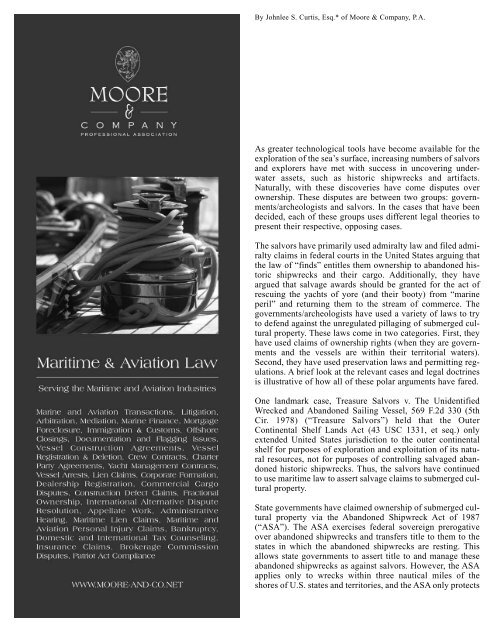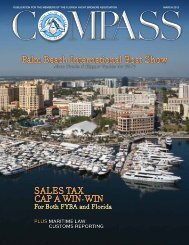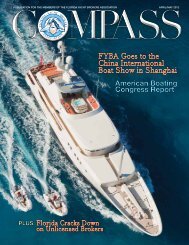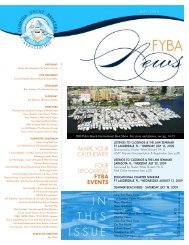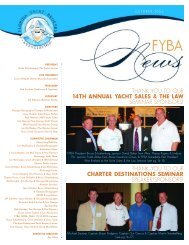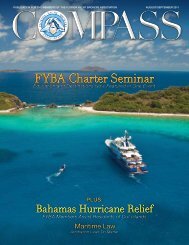August 2009 - Florida Yacht Brokers Association, Inc.
August 2009 - Florida Yacht Brokers Association, Inc.
August 2009 - Florida Yacht Brokers Association, Inc.
Create successful ePaper yourself
Turn your PDF publications into a flip-book with our unique Google optimized e-Paper software.
By Johnlee S. Curtis, Esq.* of Moore & Company, P.A.<br />
As greater technological tools have become available for the<br />
exploration of the sea’s surface, increasing numbers of salvors<br />
and explorers have met with success in uncovering underwater<br />
assets, such as historic shipwrecks and artifacts.<br />
Naturally, with these discoveries have come disputes over<br />
ownership. These disputes are between two groups: governments/archeologists<br />
and salvors. In the cases that have been<br />
decided, each of these groups uses different legal theories to<br />
present their respective, opposing cases.<br />
The salvors have primarily used admiralty law and filed admiralty<br />
claims in federal courts in the United States arguing that<br />
the law of “finds” entitles them ownership to abandoned historic<br />
shipwrecks and their cargo. Additionally, they have<br />
argued that salvage awards should be granted for the act of<br />
rescuing the yachts of yore (and their booty) from “marine<br />
peril” and returning them to the stream of commerce. The<br />
governments/archeologists have used a variety of laws to try<br />
to defend against the unregulated pillaging of submerged cultural<br />
property. These laws come in two categories. First, they<br />
have used claims of ownership rights (when they are governments<br />
and the vessels are within their territorial waters).<br />
Second, they have used preservation laws and permitting regulations.<br />
A brief look at the relevant cases and legal doctrines<br />
is illustrative of how all of these polar arguments have fared.<br />
One landmark case, Treasure Salvors v. The Unidentified<br />
Wrecked and Abandoned Sailing Vessel, 569 F.2d 330 (5th<br />
Cir. 1978) (“Treasure Salvors”) held that the Outer<br />
Continental Shelf Lands Act (43 USC 1331, et seq.) only<br />
extended United States jurisdiction to the outer continental<br />
shelf for purposes of exploration and exploitation of its natural<br />
resources, not for purposes of controlling salvaged abandoned<br />
historic shipwrecks. Thus, the salvors have continued<br />
to use maritime law to assert salvage claims to submerged cultural<br />
property.<br />
State governments have claimed ownership of submerged cultural<br />
property via the Abandoned Shipwreck Act of 1987<br />
(“ASA”). The ASA exercises federal sovereign prerogative<br />
over abandoned shipwrecks and transfers title to them to the<br />
states in which the abandoned shipwrecks are resting. This<br />
allows state governments to assert title to and manage these<br />
abandoned shipwrecks as against salvors. However, the ASA<br />
applies only to wrecks within three nautical miles of the<br />
shores of U.S. states and territories, and the ASA only protects


